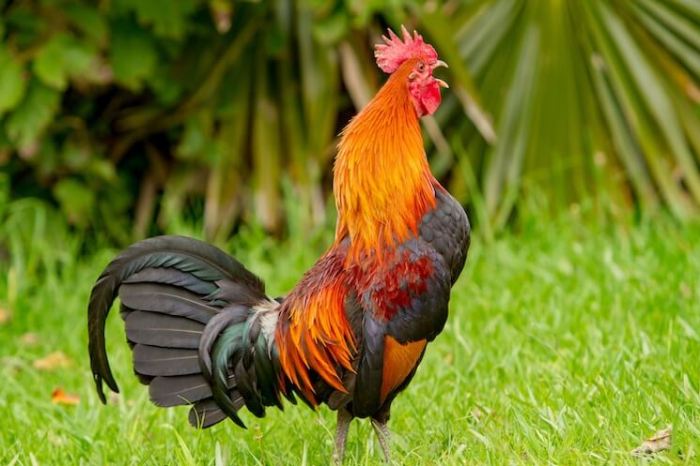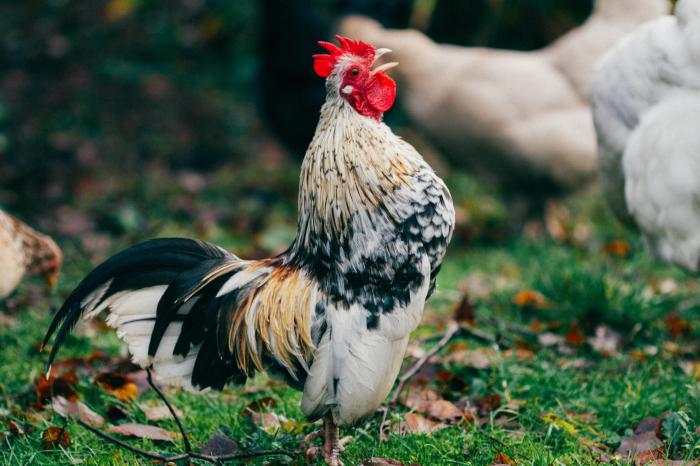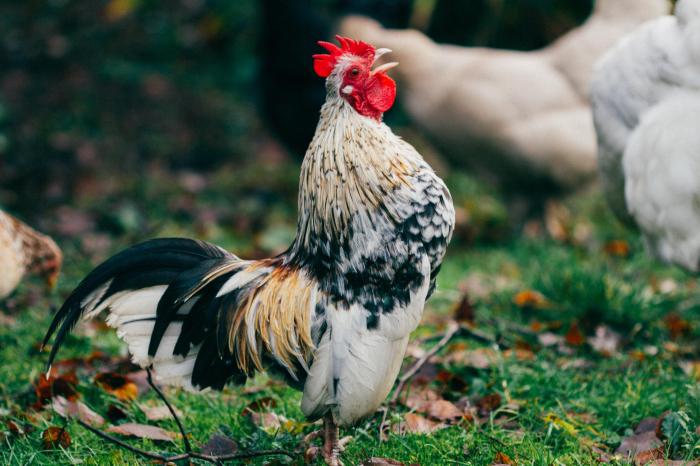Why do roosters crow in the morning? This age-old question unveils a captivating tapestry of biological rhythms, communicative strategies, environmental influences, and cultural significance. Join us as we delve into the enigmatic world of rooster crowing, exploring its scientific underpinnings, social implications, and historical resonance.
From the intricate interplay of hormones and neural pathways to the establishment of social hierarchies and territorial defense, rooster crowing serves as a multifaceted expression of avian behavior. Its rhythms are influenced by external factors such as light and temperature, while human activities and seasonal changes further shape its patterns.
Biological Reasons

The crowing behavior of roosters is primarily driven by biological factors, including circadian rhythms, hormonal influences, and neural pathways.
Circadian Rhythms
Roosters, like many other animals, possess an internal circadian clock that regulates their sleep-wake cycles and other physiological processes. This clock is synchronized with the Earth’s light-dark cycle and helps the rooster anticipate the onset of dawn.
Hormonal Factors
Hormones also play a significant role in rooster crowing. Testosterone, a hormone produced in the testes, is essential for the development and maintenance of crowing behavior. Melatonin, a hormone produced by the pineal gland, has an inhibitory effect on crowing, and its levels decrease as the day approaches.
Neural Pathways
The neural pathways involved in rooster crowing are complex and involve several brain regions. The suprachiasmatic nucleus (SCN) of the hypothalamus serves as the master clock and regulates the circadian rhythm. When the SCN detects the approach of dawn, it sends signals to the medial preoptic nucleus (MPN), which is involved in the initiation of crowing.
The MPN then activates the vocal center in the brainstem, which controls the production of crowing sounds.
Communicative Function
Beyond their role in marking the dawn, rooster crows also serve vital communicative functions within the poultry world.
Territorial Defense
Rooster crowing plays a crucial role in territorial defense. By announcing their presence, roosters deter potential intruders and protect their flock from threats. The loud and persistent nature of their crows serves as a warning to other animals, establishing clear boundaries and preventing conflicts.
Social Hierarchy
Crowing also plays a significant role in establishing and maintaining the social hierarchy within a flock. Dominant roosters crow more frequently and with greater intensity, asserting their status and discouraging challenges from subordinate members. This vocal display helps maintain order and prevents disputes, ensuring the smooth functioning of the flock.
Attracting Mates and Forming Flocks
Rooster crows are also used to attract mates and form flocks. The distinctive sound of a rooster’s crow can travel long distances, reaching potential mates and signaling their availability. By crowing, roosters establish their presence and attract hens to their territory.
Additionally, crowing can facilitate the formation of flocks, as roosters use their vocalizations to locate and join groups of other poultry.
Environmental Influences

The crowing behavior of roosters is influenced by various environmental factors, including light, temperature, and the presence of predators. Artificial lighting and noise from human activities can also impact their crowing patterns.
Light
Light is a primary cue that triggers crowing in roosters. As the day approaches, the increasing light intensity stimulates the pineal gland, which in turn suppresses the production of melatonin, a hormone that promotes sleep. This decrease in melatonin levels leads to an increase in testosterone production, which triggers crowing behavior.
Temperature
Temperature also plays a role in rooster crowing. Roosters are more likely to crow during warmer temperatures. This is because higher temperatures increase their metabolic rate and energy levels, making them more active and vocal.
Predators
The presence of predators can influence rooster crowing patterns. Roosters may crow more frequently to alert the flock of potential danger. This is especially true during the early morning hours when predators are most active.
The morning crow of a rooster is a familiar sound, but why do they crow? One theory is that they are announcing the dawn to their flock. However, some studies suggest that roosters may also crow to establish their territory or attract mates.
If you’re curious about the time, you can check what time Dunkin’ opens to get your morning coffee and breakfast. Roosters typically crow at sunrise, but the exact time can vary depending on the season and location.
Human Activity
Human activities, such as artificial lighting and noise, can also affect rooster crowing behavior. Artificial lighting can disrupt the rooster’s natural circadian rhythm, leading to changes in crowing patterns. Noise can also startle roosters and cause them to crow more frequently.
Seasonal Changes
Seasonal changes can also influence rooster crowing patterns. During the spring and summer months, when days are longer and temperatures are warmer, roosters tend to crow more frequently. This is because they are more active and have higher testosterone levels during these seasons.
Cultural and Historical Significance
Rooster crowing has a rich and diverse cultural and historical significance across various civilizations and time periods. Throughout history, roosters have been revered for their timekeeping abilities and have played a vital role in religious rituals, folklore, and cultural traditions.
Timeline of Historical and Cultural Associations
* Ancient Egypt:Roosters were associated with the sun god Ra and were considered sacred animals. Their crowing was believed to herald the dawn and ward off evil spirits.
Ancient Greece
Roosters were sacred to Apollo, the god of music and prophecy. Their crowing was seen as a sign of good luck and victory.
Ancient Rome
Roosters were kept in temples as timekeepers and were used for divination purposes. Their crowing was interpreted as a sign from the gods.
Medieval Europe
Roosters were associated with vigilance and protection. They were often kept in castles and monasteries to warn of approaching danger.
Christian Tradition
The rooster’s crowing is mentioned in the Bible as a symbol of repentance and a reminder of Christ’s betrayal.
Japanese Culture
In Japan, roosters are considered a symbol of courage and good fortune. Their crowing is believed to bring happiness and prosperity.
Hinduism
In Hinduism, roosters are associated with the god Vishnu. Their crowing is seen as a symbol of the awakening of consciousness and the triumph of good over evil.
Practical Applications
Rooster crowing has practical applications in various fields, including timekeeping and animal husbandry.
Methods of Controlling Rooster Crowing
Several methods can be used to control or mitigate rooster crowing:
| Method | Description |
|---|---|
| Physical Barriers | Physical barriers, such as soundproofing or enclosing the rooster in a coop, can help reduce noise levels. |
| Noise Reduction | Noise reduction techniques, such as using white noise machines or soundproofing materials, can help mask the crowing. |
| Behavioral Modification | Behavioral modification techniques, such as training the rooster to crow at specific times or providing alternative outlets for their energy, can help reduce crowing. |
Ethical Considerations, Why do roosters crow in the morning
Rooster crowing can have an impact on human communities, particularly in urban areas where noise levels are a concern. Ethical considerations should be taken into account when addressing rooster crowing, including the rights of the rooster and the well-being of the community.
Final Wrap-Up: Why Do Roosters Crow In The Morning
Rooster crowing, a seemingly simple act, is in fact a complex symphony of biology, communication, and culture. Understanding its intricacies not only enriches our appreciation for the natural world but also sheds light on our own interactions with animals and the environment.
Whether as a symbol of dawn or a source of debate, rooster crowing continues to captivate and inspire.





